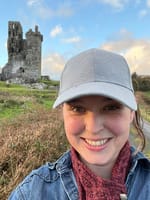Discussions of Ireland's historical record often begin from a place of fragmentation and loss. The 1922 shelling of the Four Courts, which housed Ireland's Public Records Office, was a dramatic and devastating culmination to centuries of archival erosion through both deliberate damage and neglect. Although a portion of the records in the Four Courts survived the fire, most of Ireland's archival record is preserved in surrogates – copies, calendar entries, and descriptions – if it is preserved at all. For generations of scholars, those cascading losses contributed to an overwhelming narrative of silence, of medieval Ireland as unknowable.
The losses are real, and they pose significant methodological challenges for the historian. But they also invite creative and critical engagement with what remains. An Duilleog, The Leaf, begins not with loss but with regrowth and regeneration. The metaphor of the leaf calls to mind both trees and manuscripts, and invites us to consider what the fragment can tell us about the whole – what can we learn about medieval Ireland from what remains, and how can the challenges of a fragmentary archival record encourage us to generate creative, interdisciplinary approaches to the work of the historian?
We're fortunate in this endeavor that Ireland has invested heavily in digitization projects that render what remains more accessible. Projects like the Virtual Record Treasury of Ireland, which seeks to recreate the Public Records Office through surviving documents and surrogates; Irish Script on Screen, which celebrates Irish manuscript culture; and CELT: Corpus of Electronic Texts, which has been providing high quality digital editions of medieval texts since the 1990s: all of these provide rich fodder for exploring Ireland's medieval past.
In this blog, we'll explore a variety archival, archaeological, and digital sources for medieval Ireland. This is a space for experimentation and dabbling, and sometimes the questions we pose won't have a clear answer. But through this process, we'll work to build new narratives that reframe medieval Ireland as a site of agency and activity.
